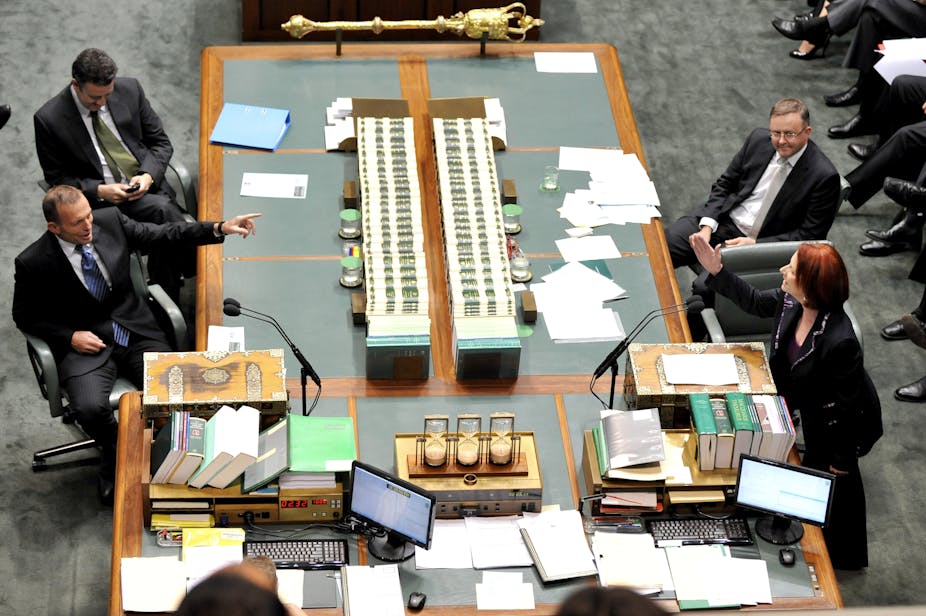Last week, prime minister Julia Gillard told the Australian public they’d be able to tell the difference between campaigning and governing during this election year.
Over the following days, which saw a former federal Labor MP arrested for fraud, a former state Labor MP testifying before a corruption commission, the resignation of two senior government ministers and a senior Liberal comparing Gillard’s government to the final days of the Nazi regime, the Australian public would be forgiven for failing to do so, or at least wondering when the governing might actually begin.
It’s no wonder some commentators have expressed doubt about the sustainability of the distinction between campaigning and governing. They argue that once an election date is set, the “days of campaigning” begin, regardless of when the writs are issued.
The distinction between governing and campaigning has become more and more blurred in recent times, with campaigning now stretched across the three-year electoral cycle. This is the “permanent campaign” – the idea that politicians are now constantly in campaign mode, as a result of the increasing intensity of media coverage in an era of satellite TV and 24 hour news stations (see Pippa Norris’s book, A Virtuous Circle). When Australian commentators complain about the dominance of spin and the superficial nature of media coverage, this is partly linked to this idea of the permanent campaign.
What’s left for Labor?
One of the ironies of the current minority government, though, is that a toxic political environment, saturation media coverage, and constant sense of crisis have actually not prevented the government from governing. Despite the difficulties it has faced, the current Labor Government has managed to pass significant reforms, most notably, the introduction of the carbon tax and the mining tax.
Although its opportunities to achieve further reform are likely to be limited as it heads into the pre-election period, the government is likely to use its final “days of governing” to bring in the National Disability Insurance Scheme (NDIS) and the Gonski education reforms.
The government has already made a firm commitment to bringing in the NDIS, introducing a draft bill to Parliament in November and [funding the first stage of the scheme](http://www.smh.com.au/opinion/political-news/gillard-introduces-ndis-bill-20121129-2ah2z.html](http://www.smh.com.au/opinion/political-news/gillard-introduces-ndis-bill-20121129-2ah2z.html ). The prime minister has expressed overall support for the Gonski reforms, although detailed announcements regarding funding have yet to be made.
It would make sense for the government to prioritise these reforms in the limited time it has left before the next election. They could turn out to be the most important policy legacy of Labor’s six years in office, and are also in line with Labor’s traditional commitment to equality of opportunity and providing a strong level of social protection to citizens.
There may also be electoral advantages for the government in bedding down these reforms. It would mean a stronger case could be made for its reform credentials in the social policy area, appealing to its support base. These reforms are also likely to appeal to voters in marginal seats where issues such as education and financial security are particularly important.
Death of a legacy
With an election date in place, it is also worth considering what the likely consequences of electoral defeat will be for Labor’s agenda.
Once again, despite the relative pessimism about the state of Australian politics, on issues such as industrial relations, climate change, and taxation, there are important differences between the major parties.
In industrial relations, for instance, although opposition leader Tony Abbott has rejected a return to WorkChoices, he spoke positively of the reforms in his 2009 book, Battlelines, and he has been critical of the Fair Work Act.
This suggests that further labour market deregulation is likely to be on the agenda under a Coalition government, even if it does not go as far as WorkChoices. At his speech to the National Press Club last week, Abbott also reaffirmed his commitment to abolishing the carbon tax and the mining tax. Thus, three of the major policy reforms introduced by the Labor government – in industrial relations, climate change and tax – are likely to be overturned if a Coalition government were elected.
In the social policy area, there are also likely to be differences between Labor and the Coalition. Abbott has been critical of the Gonski reforms, questioning their affordability.
In contrast, he has indicated in principle support for the NDIS reforms, although funding appears to be dependent on the [budget being back in surplus](http://www.afr.com/p/national/abbott_won_be_lectured_to_on_immigration_MOyHLMXw375DB8kwulRnwK](http://www.afr.com/p/national/abbott_won_be_lectured_to_on_immigration_MOyHLMXw375DB8kwulRnwK).
Given the opposition’s commitment to repealing the mining tax and the carbon tax, while retaining the tax cuts introduced by Labor, there must be some doubt over how soon the Coalition would be able to introduce these reforms.
The campaign we deserve
Despite how things may seem, there are, in fact, significant differences between the major parties.
The next election is likely to have important implications for climate change, taxation, industrial relations and, in all likelihood, social policy.
It would therefore be conceivable to have a seven-month lead-up to the election dominated by genuine debate over policy, with both major parties putting forward competing approaches, and media coverage focused on substantive issues rather than horse-race journalism.
But if the past week has taught us anything, it’s likely that this will be a forlorn hope. Sadly, the pattern that has taken hold over the past two-and-a-half years is likely to remain firmly in place.

